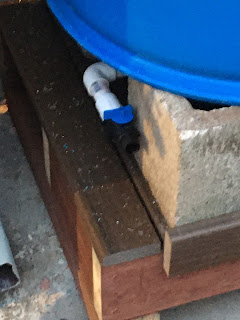Google maps showed us that there had been a concrete pad in front of our house where they used to park a car.
To improve "curb appeal" for the most recent sale, the concrete was removed and sod was installed. While grass is soothing and many people find it visually appealing, especially if you grew up somewhere where lawns are common, a summer-dry Mediterranean climate like ours is not suited to lawns. So we always had plans to remove it and replant. After we had the main water line to the house replaced, there was a large swath down the middle of the yard of upturned soil so it seemed like a good time to get started on removing the rest of the grass. We did try posting "Free Sod" ads on Facebook and NextDoor, but no one took us up on it, so we got to work with shovels!
Working methodically across the lawn, we cut chunks of sod and flipped them grass-side down. Then we laid large pieces of cardboard on top. Finally, 2" of compost will be spread on top of the cardboard. It will take a couple of months for the cardboard and grass to decompose and leave us with planting space that has more organic matter. This is especially important since I discovered we have some pretty heavy clay in the front yard. The ideal soil texture is loam. Clay holds too much water in winter and turns into brick-like chunks in summer. It's pretty much the exact opposite problem from the soil I had in the Presidio- which was almost pure sand. Sand doesn't hold water at all. Silt is the third soil texture category.

https://www.soils4teachers.org/physical-properties
https://www.growveg.com/guides/understanding-soil-types-for-vegetable-gardens/
The solution to both problems is more organic matter in the soil. You can accomplish this by adding finished compost, planting cover crops that you turn in, or sheet mulching, which is what I'm attempting. Ideally, sheet mulching would have multiple layers including organic matter such as horse manure, straw, coffee grounds, wood chips, and compost. Compost is almost always the solution! The other option is to build raised beds and add new soil. Raised beds have a lot of benefits we'll talk about later.
EBMUD offers rebates for residents who remove lawns and lawn irrigation! We didn't have any irrigation in our lawn but maybe you do? Check it out: https://www.ebmud.com/water/conservation-and-rebates/rebates/lawn-conversion-rebate/ Save water and replant your lawn with native plants and drought-tolerant plants suited to our summer-dry climate. There are several nurseries that specialize in these plants. Or, if you are going to use water, grow food with it :)
Here are a few nearby nurseries:
http://www.spiralgardens.org/nursery.html












